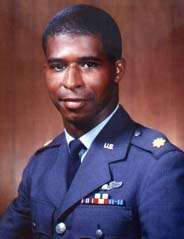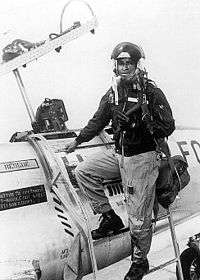Robert Henry Lawrence Jr.
| Robert Henry Lawrence Jr. | |
|---|---|
 | |
| USAF Astronaut | |
| Nationality | American |
| Born |
Robert Henry Lawrence Jr. October 2, 1935 Chicago, Illinois, U.S. |
| Died |
December 8, 1967 (aged 32) Edwards Air Force Base, California, U.S. |
Other occupation | Test pilot |
|
Bradley University, B.S. 1956 Ohio State University, Ph.D. 1965 | |
| Rank |
|
Time in space | None |
| Selection | 1967 USAF MOL Group 3 |
| Missions | None |
Mission insignia | None |
Robert Henry Lawrence Jr. (October 2, 1935 – December 8, 1967), (Major, USAF), was a United States Air Force officer and the first African-American astronaut.[1]
Early years
Lawrence was born October 2, 1935, in Chicago, Illinois. He attended Haines Elementary School and, at the age of 16, he graduated in the top 10 percent from Englewood High School in Chicago, in 1952. At the age of 20, he graduated from Bradley University with a Bachelor of Science degree in Chemistry. At Bradley, he distinguished himself as Cadet Commander in the Air Force ROTC and received the commission of second lieutenant in the Air Force Reserve Program.
Air Force

At the age of 21, he was designated as a U.S. Air Force pilot after completing flight training at Malden Air Force Base, Missouri.
At 22, he married Barbara Cress, daughter of Dr. and Mrs. Henry Cress of Chicago. By the time he was 25, he had completed an Air Force assignment as an instructor pilot in the T-33 training aircraft for the German Air Force.
In 1965, Lawrence earned a Ph.D. in Physical Chemistry from Ohio State University. His doctoral thesis was "The Mechanism Of The Tritium Beta Ray Induced Exchange Reaction Of Deuterium With Methane and Ethane In The Gas Phase."[2][3]
He was a senior USAF pilot, accumulating well over 2,500 flight hours, 2,000 of which were in jets. Lawrence flew many tests in the Lockheed F-104 Starfighter to investigate the gliding flight of various unpowered spacecraft returning to Earth from orbit, such as the North American X-15 rocket-plane. NASA cited Lawrence for accomplishments and flight maneuver data that "contributed greatly to the development of the Space Shuttle."[1]
Astronaut
— Barbara Cress Lawrence, Lawrence's widow, about her late husband's MOL experience.[4]
In June 1967, Lawrence successfully completed the U.S. Air Force Test Pilot School (Class 66B) at Edwards AFB, California. The same month, he was selected by the USAF as an astronaut in the Air Force's Manned Orbital Laboratory (MOL) program, thus becoming the first black astronaut.
Robert Henry Lawrence was also a member of Omega Psi Phi fraternity.[5]
Death
Lawrence was killed in the crash of an F-104 Starfighter at Edwards Air Force Base, California, on December 8, 1967, at 32 years of age. He was flying backseat on the mission as the instructor pilot for a flight test trainee learning the steep-descent glide technique. The pilot flying made such an approach but flared too late. The airplane struck the ground hard, its main gear failed, it caught fire, and rolled. The front-seat pilot ejected upward and survived, with major injuries. The back seat, which delays a moment to avoid hitting the front seat, ejected sideways, killing Lawrence instantly. Had Lawrence lived, he likely would have been among the MOL astronauts who became NASA Astronaut Group 7 after MOL's cancellation, all of whom flew on the Space Shuttle.[6] During his brief career, Lawrence earned the Air Force Commendation Medal, the Outstanding Unit Citation. On December 8, 1997, his name was inscribed on the Space Mirror Memorial at the Kennedy Space Center in Florida.[1]
See also
References
- 1 2 3 Maj. Robert H. Lawrence Archived 2009-08-10 at the Wayback Machine. from the U.S. Air Force's official website
- ↑ Chemistry Department Scholarships Archived 2009-07-19 at the Wayback Machine. from the Bradley University website
- ↑ The mechanism of the tritium beta-ray induced exchange reactions of deuterium with methane and ethane in the gas phase
- ↑ "SECRET ASTRONAUTS – Maj. Robert H. Lawrence Jr, USAF". Pbs.org.
- ↑ Epps, Henry. Great African-American Men in America history vol II. p. 62. ISBN 9781300161622.
- ↑ Oberg, James H. (2005-02-23). "The Unsung Astronaut". MSNBC. Archived from the original on 2011-03-07. Retrieved 2011-01-27.
External links
| Wikimedia Commons has media related to Robert Henry Lawrence Jr.. |